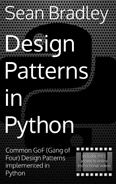Summary
A table of one-liners to help summarize the design patterns in this website.
| Pattern | Description |
|---|---|
| Abstract Factory | Adds an abstraction over many other related objects that are created using other creational patterns. |
| Adapter | An alternative interface over an existing interface. |
| Bridge | The Bridge pattern is similar to the Adapter pattern except in the intent that you developed it. |
| Builder | A creational pattern whose intent is to separate the construction of a complex object from its representation so that you can use the same construction process to create different representations. |
| Chain of Responsibility | Pass an object through a chain of successor handlers. |
| Command | An abstraction between an object that invokes a command, and the object that performs it. Useful for UNDO/REDO/REPLAY. |
| Composite | A structural pattern useful for hierarchical management. |
| Decorator | Attach additional responsibilities to an object at runtime. |
| Facade | An alternative or simplified interface over other interfaces. |
| Factory | Abstraction between the creation of an object and where it is used. |
| Flyweight | Share objects rather than creating thousands of near identical copies. |
| Interpreter | Convert information from one language to another. |
| Iterator | Traverse a collection of aggregates. |
| Mediator | Objects communicate through a Mediator rather than directly with each other. |
| Memento | Save a copy of state and for later retrieval. Useful for UNDO/REDO/LOAD/SAVE. |
| Observer Pattern | Manage a list of dependents and notifies them of any internal state changes. |
| Prototype | Good for when creating new objects requires more resources than you need of have available. |
| Proxy | A class functioning as an interface to another class or object. |
| Singleton | A class that can be instanced at any time, but after it is first instanced, any new instances will point to the original instance. |
| State | Alter an objects behavior by changing the handle of one of its methods to one of its subclasses dynamically to reflect its new internal state. |
| Strategy | Similar to the State Pattern, except that the client passes in the algorithm that the context should then run. |
| Template Method | An abstract class (template) that contains a method that is a series of instructions that are a combination of methods that can be overridden. |
| Visitor | Pass an object called a visitor to a hierarchy of objects and execute a method on them. |
Remember that design patterns will give you a useful and common vocabulary for when designing, documenting, analyzing, restructuring new and existing software development projects now and into the future.
Good luck and I hope that your projects become very successful.
Sean Bradley






























